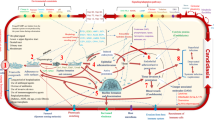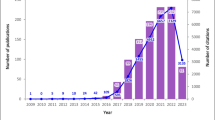Abstract
Cryptococcus neoformans is a basidiomycete that can cause life-threatening meningoencephalitis in patients with and without impaired immune function. Cryptococcosis is usually an opportunistic infection in patients with compromised immunity as a consequence of HIV-1 infection, steroid administration, cancer chemotherapy, sarcoidosis, diabetes, or inherited immune system defects. This pathogenic yeast has a defined sexual cycle, which allows classical genetic analysis. Molecular biology approaches, including transformation and gene disruption by homologous recombination, and animal models for studies of virulence are both well developed. Recently an international consortium convened to begin the C. neoformans genome sequencing project, and we review here background and arguments for this project. We also discuss the importance of this project to the biology and virulence of this organism in particular, and to virulence in general.
Similar content being viewed by others
References
Adams MD, Celniker SE, Holt RA, et al. The genome sequence of Drosophila melanogaster. Science 2000; 287: 2185–2195.
Blattner FR, Plunkett GR, Bloch CA et al. The complete genome sequence of Escherichia coli K-12. Science 1997; 277: 1453–74.
Mewes HW, Albermann K, Bahr M et al. Overview of the yeast genome. Nature 1997; 387: 7–65.
The C. elegans sequencing consortium: Genome sequence of the nematode C. elegans: a platform for investigating biology. The C. elegans Sequencing Consortium. Science 1998; 282: 2012–2018.
Kwon-Chung KJ. A new genus, Filobasidiella, the perfect state of Cryptococcus neoformans. Mycologia 1975; 67: 1197–1200.
Kwon-Chung KJ. Morphogenesis of Filobasidiella neoformans, the sexual state of Cryptococcus neoformans. Mycologia 1976; 68: 821–833.
Alspaugh JA, Davidson RC, Heitman J. Morphogenesis of Cryptococcus neoformans. In: Ernst JF, Schmidt A, eds. Dimorphism in Human Pathogenic and Apathogenic Yeasts, vol 5. Basel, Karger, Switzerland: Contrib Microbiol 2000; 217–238.
Wickes BL, Mayorga ME, Edman U, Edman JC. Dimorphism and haploid fruiting in Cryptococcus neoformans: Association with the β-mating type. Proc Natl Acad Sci USA 1996; 93: 7327–7331.
Wang P, Perfect JR, Heitman J. The G-protein β subunit GPB1 is required for mating and haploid fruiting in Cryptococcus neoformans. Mol Cell Biol 2000; 20: 352–362.
Kwon-Chung KJ, Rhodes JC. Encapsulation and melanin formation as indicators of virulence in Cryptococcus neoformans. Infect Immun 1986; 51: 218–223.
Salas SD, Bennett JE, Kwon-Chung KJ, Perfect JR, Williamson PR. Effect of the laccase gene, CNLAC1, on virulence of Cryptococcus neoformans. J Exp Med 1996; 184: 377–386.
Wang Y, Casadevall A. Susceptibility of melanized and nonmelanized Cryptococcus neoformans to nitrogen-and oxygenderived oxidants. Infect Immun 1994; 62: 3004–3007.
Nosanchuk JD, Rosas AL, Casadevall A. The antibody response to fungal melanin in mice. J Immunol 1998; 160: 6026–6031.
Nosanchuk JD, Valadon P, Feldmesser M, Casadevall A. Melanization of Cryptococcus neoformans in murine infection. Mol Cell Biol 1999; 19: 745–750.
Chang YC, Kwon-Chung KJ. Complementation of a capsuledeficient mutation of Cryptococcus neoformans restores its virulence. Mol Cell Biol 1994; 14: 4912–4919.
Hamilton AJ, Goodley J. Virulence factors of Cryptococcus neoformans. Curr Top Med Mycol 1996; 7: 19–42.
Edman JC, Kwon-Chung KJ. Isolation of the URA5 gene from Cryptococcus neoformans var. neoformans and its use as a selective marker for transformation. Mol Cell Biol 1990; 10: 4538–4544.
Toffaletti DL, Rude TH, Johnston SA, Durack DT, Perfect JR. Gene transfer in Cryptococcus neoformans by use of biolistic delivery of DNA. J Bacteriol 1993; 175: 1405–1411.
Lodge JK, Jackson-Machelski E, Toffaletti DL, Perfect JR, Gordon JI. Targeted gene replacement demonstrates that myristoyl-CoA:protein N-Myristoyltransferase is essential for viability of Cryptococcus neoformans. Proc Natl Acad Sci USA 1994; 91: 12008–12012.
Odom A, Muir S, Lim E, Toffaletti DL, Perfect J, Heitman J. Calcineurin is required for virulence of Cryptococcus neoformans. EMBO J 1997; 16: 2576–2589.
Kwon-Chung KJ, Edman JC, Wickes BL. Genetic association of mating types and virulence in Cryptococcus neoformans. Infect Immun 1992; 60: 602–605.
Heitman J, Allen B, Alspaugh JA, Kwon-Chung KJ. On the origins of the congenic MATα and MATa strains of the pathogenic yeast Cryptococcus neoformans. Fungal Genet Biol 1999; 28: 1–5.
Davidson RC, Cruz MC, Sia RAL, Allen BM, Alspaugh JA, Heitman J. Gene disruption by biolistic transformation in serotype D strains of Cryptococcus neoformans. Fungal Genet Biol 2000; 29: 38–48.
Del Poeta M, Toffaletti DL, Rude TH, Dykstra CC, Heitman J, Perfect JR. Topoisomerase I is essential in Cryptococcus neoformans: role in pathobiology and as an antifungal target. Genetics 1999; 152: 167–178.
Thompson JR, Douglas CM, Li W, et al. A glucan synthase FKS1 homolog in Cryptococcus neoformans is single copy and encodes an essential function. J Bacteriol 1999; 181: 444–453.
Perfect JR, Lang SDR, Durack DT. Chronic cryptococcal meningitis: a new experimental model in rabbits. Am J Pathol 1980; 101: 177–194.
Goldman D, Cho Y, Zhao M, Casadevall A, Lee SC. Expression of inducible nitric oxide synthase in rat pulmonary Cryptococcus neoformans granulomas. Am J Pathol 1996; 148: 1275–1282.
Perfect JR, Toffaletti DL, Rude TH. The gene encoding phosphoribosylaminoimidazole carboxylase (ADE2) is essential for growth of Cryptococcus neoformans in cerebrospinal fluid. Infect Immun 1993; 61: 4446–4451.
Alspaugh JA, Perfect JR, Heitman J. Cryptococcus neoformans mating and virulence are regulated by the G-protein αsubunit GPA1 and cAMP. Genes & Dev 1997; 11: 3206–3217.
Cruz MC, Sia RAL, Olson M, Cox GM, Heitman J. Comparison of the roles of calcineurin in physiology and virulence in serotype D and serotype A strains of Cryptococcus neoformans. Infect Immun 2000; 68: 982-985.
Falkow S. Molecular Koch's postulates applied to microbial pathogenicity. Rev Infect Dis 1988; 10: S274–276.
Kwon-Chung KJ, Bennett JE. Distribution of α and a mating types of Cryptococcus neoformans among natural and clinical isolates. Am J Epidemiol 1978; 108: 337–340.
Halliday CL, Bui T, Krockenberger M, Malik R, Ellis DH, Carter DA. Presence of alpha and a mating types in environmental and clinical collections of Cryptococcus neoformans var. gattii strains from Australia. J Clin Microbiol 1999; 37: 2920–2926.
Sukroongreung S, Kitiniyom K, Nilakul C, Tantimavanich S. Pathogenicity of basidiospores of Filobasidiella neoformans var. neoformans. Medical Mycology 1998; 36: 419–424.
Moore TDE, Edman JC. The α-mating type locus of Cryptococcus neoformans contains a peptide pheromone gene. Mol Cell Biol 1993; 13: 1962–1970.
Wickes BL, Edman U, Edman JC. The Cryptococcus neoformans STE12α gene: a putative Saccharomyces cerevisiae STE12 homologue that is mating type specific. Mol Microbiol 1997; 26: 951–960.
Yue C, Cavallo LM, Alspaugh JA, et al. The STE12α homolog is required for haploid filamentation but largely dispensable for mating and virulence in Cryptococcus neoformans. Genetics 1999; 153: 1601–1615.
Chang YC, Wickes BL, Miller GF, Penoyer LA, Kwon-Chung KJ. Cryptococcus neoformans STE12α regulates virulence but is not essential for mating. J Exp Med 2000; 191: 871–882.
Wang P, Heitman J. Signal transduction cascades regulating mating, filamentation, and virulence in Cryptococcus neoformans. Curr Opinion Microbiol 1999; 2: 358–362.
Alspaugh JA, Perfect JR, Heitman J. Signal transduction pathways regulating differentiation and pathogenicity of Cryptococcus neoformans. Fungal Genet Biol 1998; 25: 1–14.
Goldman DL, Lee SC, Mednick AJ, Montella L, Casadevall A. Persistent Cryptococcus neoformans pulmonary infection in the rat is associated with intracellular parasitism, decreased inducible nitric oxide synthase expression, and altered antibody responsiveness to Cryptococcal polysaccharide. Infect Immun 2000; 68: 832–8.
Granger DL, Perfect JR, Durack DT. Virulence of Cryptococcus neoformans: regulation of capsule synthesis by carbon dioxide. J Clin Invest 1985; 76: 508–516.
Vartivarian SE, Anaissie EJ, Cowart RE, Sprigg HA, Tingler MJ, Jacobson ES. Regulation of cryptococcal capsular polysaccharide by iron. J Infect Dis 1993; 167: 186–190.
Vietri NJ, Marrero R, Hoover TA, Welkos SL. Identification and characterization of a trans-activator involved in the regulation of encapsulation by Bacillus anthracis. Gene 1995; 152: 1–9.
Franzot SP, Mukherjee J, Cherniak R, Chen LC, Hamdan JS, Casadevall A. Microevolution of a standard strain of Cryptococcus neoformans resulting in differences in virulence and other phenotypes. Infect Immun 1998; 66: 89–97.
Goldman DL, Fries BC, Franzot SP, Montella L, Casadevall A. Phenotypic switching in the human pathogenic fungus Cryptococcus neoformans is associated with changes in virulence and pulmonary inflammatory response in rodents. Proc Natl Acad Sci USA 1998; 95:14967–14972.
Cruz MC, Cavallo LM, Görlach JM, et al. Rapamycin antifungal action is mediated via conserved complexes with FKBP12 and TOR kinase homologs in Cryptococcus neoformans. Mol Cell Biol 1999; 19: 4101–4112.
Edman JC. Isolation of telomerelike sequences from Cryptococcus neoformans and their use in high-efficiency transformation. Mol Cell Biol 1992; 12: 2777–2783.
Kwon-Chung KJ. A new species of Filobasidiella, the sexual state of Cryptococcus neoformans B and C serotypes. Mycologia 1976; 68: 943–946.
Meyer W, Marszewska K, Amirmostofian M et al. Molecular typing of global isolates of Cryptococcus neoformans var. neoformans by polymerase chain reaction fingerprinting and randomly amplified polymorphic DNA - a pilot study to standardize techniques on which to base a detailed epidemiological survey. Electrophoresis 1999; 20: 1790–1799.
Franzot SP, Salkin IF, Casadevall A. Cryptococcus neoformans var. grubii: Separate varietal status for Cryptococcus neoformans serotype A isolates. J Clin Microbiol 1999; 37: 838–840.
Franzot SP, Hamdan JS, Currie BP, Casadevall A. Molecular epidemiology of Cryptococcus neoformans in Brazil and the United States: evidence for both local genetic differences and a global clonal population structure. J Clin Microbiol 1997; 35: 2243–2251.
Buchanan KL, Murphy JW. What makes Cryptococcus neoformans a pathogen? Emerg Infect Dis 1998; 4: 71–83.
Author information
Authors and Affiliations
Rights and permissions
About this article
Cite this article
Heitman, J., Casadevall, A., Lodge, J.K. et al. The Cryptococcus neoformans genome sequencing project. Mycopathologia 148, 1–7 (1999). https://doi.org/10.1023/A:1007136602930
Issue Date:
DOI: https://doi.org/10.1023/A:1007136602930




